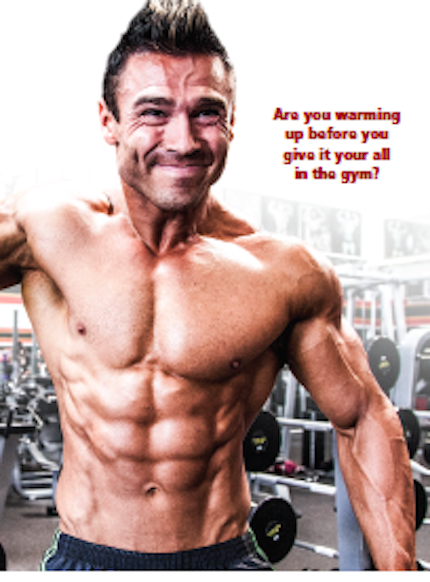Sports Medicine


Necessity of Warm Up and Cool Down
Most gym members think warming up for weight training just means jumping on a treadmill for ve to 10 minutes to get the heart rate up, but top bodybuilders and powerlifters know the warm-up actually consists of five different components:
1. Increasing body temperature
2. Mental exercise rehearsal
3. Heightened emotional state of readiness
4. Motor pattern activation
5. Increased drive of the adrenal hormones
All of these components help answer a question that top bodybuilders and powerlifters constantly ask: “How can I have the best workout of my life?” The answer always starts with the warm-up, and each component has different priorities based on the type of workout you’re doing and where you live.

The first component is increasing body temperature, and it’s only important if you live in a cold climate. If you need to increase overall body temperature and increase blood circulation because you’re cold, this can be done by doing a few minutes on a treadmill at low intensity. But if you live in a warm climate, this component of the warm-up isn’t needed. At bodybuilding gyms in California or Florida, you won’t see a competitive bodybuilder on a treadmill before working out. The second warm-up component is mental exercise rehearsal, which is visualizing the main exercise of the day in your mind’s eye in perfect form. This is usually done by remembering a past workout when the weight “felt” light and you set a new personal record for weight being lifted. Another way is visually remembering a video you watched of one of the top bodybuilders or powerlifters training and trying to copy his or her style and intensity. Arnold was a big proponent of this technique.

This mental exercise rehearsal activates the third warm-up component, which is a heightened emotional state of exercise readiness. When you’re trying to have the best workout of your life, you have to be emotionally ready. This is done by listening to music that cranks you up, emotionally talking to yourself or your training partner, breathing faster, and/or staring o at a distance and focusing. The emotional state that you’re trying to achieve is a controlled rage that is on simmer. When you’re going for some max attempts, you crank up the emotional temperature to high, but you can only do this for one or two sets. The fourth warm-up component happens when you get into the gym and physically rehearse the main exercise with an empty bar with perfect form. This activates the optimal movement pattern of the nervous system to ensure that each rep will count when the weight gets heavy. Top lifters always use light weight repeatedly, which readies and conditions the nervous system for the heavy sets. The fifth warm-up component is increased drive of the adrenal hormones and is based on the intensity of the first four components. The more mentally and emotionally ready you are, the higher your adrenal hormone output will be, which will help you have the best workout of your life. As far alife. As far as cooling down goes, very rarely do I see bodybuilders stretch. They may do some low-intensity cardio for metabolic reasons, but not for cooling down. The only cooldown bodybuilders do is posing practice to help with muscle control if they’re close to a bodybuilding show.
To read more about injury prevention and treatments, click here!
Photos courtesy of Thinkstock
Photo of Larry Vinette courtesy of

